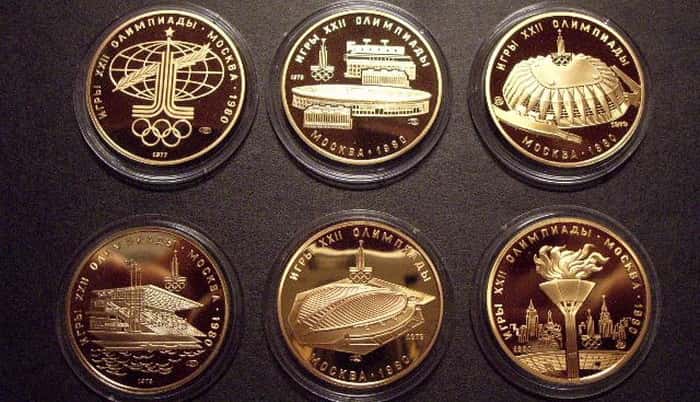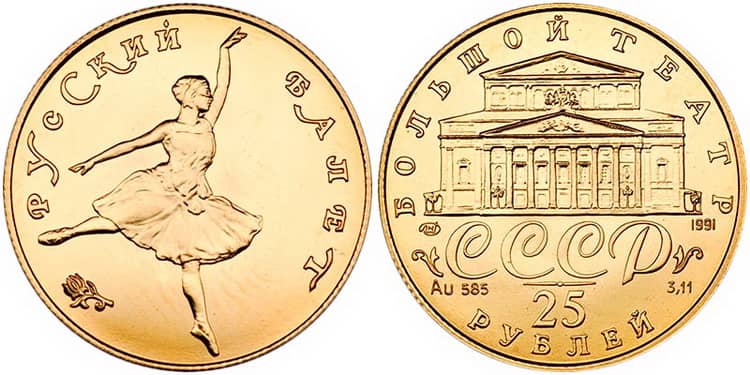
Soviet gold coins began to be minted a year after the formation of the USSR in 1923, and the last coin was issued in 1991, when the union of the republics collapsed. In total, there are five denominations of commemorative collection coins of gold, which were released during this period −10, 25, 50 and 100 rubles. All of them were dedicated to one or another political figure, historical event and architectural structure. All Soviet gold coins in our catalog.
Types of Soviet Gold Coins
10 rubles denomination
10 rubles, or chervonets “Sower” of 1923

All 10 Roubles Soviet gold coins in our catalog.
25 rubles denomination
25 rubles of 1991

All 25 Roubles Soviet gold coins in our catalog.
50 rubles denomination
50 rubles of 1988

50 rubles of 1989

50 rubles of 1990

50 rubles of 1991

You can find all 50 Roubles Soviet gold coins in our catalog.
100 rubles denomination
100 rubles of 1980



100 rubles of 1988

100 rubles of 1989

100 rubles of 1990

100 rubles of 1991

All 100 Roubles Soviet gold coins in our catalog.
Circulations of Soviet gold coins
All types of gold coins of the Soviet period were minted in small editions of not more than 25,000 samples. The only exception is the coin “Sower” of 1923, the circulation of which amounted to almost 3 million coins. Nowadays the number of surviving copies of the “Sower” is so small that this coin is the rarest Soviet gold coin.
- The Golden “Sower” of 10 rubles was minted from March 1923 to September 1924 with a circulation of 2,751,201 samples.
- 50 rubles of 1988 “1000th Anniversary of Russian Architecture. Cathedral of St. Sophia, Novgorod” with a circulation of 25,000 samples.
- 50 rubles of 1989 “500th Anniversary of the United Russian State. Assumption Cathedral, Moscow” with a circulation of 25,000 samples.
- 50 rubles of 1990 “500th Anniversary of the United Russian State Church of the Archangel Gabriel, with a circulation of 25,000 samples.
- 50 rubles of 1990 “500th Anniversary of the United Russian State. St. Isaac’s Cathedral, with a circulation of 25,000 samples.
- 100 rubles of 1989 “500th Anniversary of the United Russian State” with a circulation of 14,000 samples.
- 100 rubles of 1988 “1000th Anniversary of Russian Minting Serie. Vladimir’s Gold Coin” with a circulation of 14,000 samples.
- 100 rubles of 1989 “500th Anniversary of the United Russian State. State Seal of Ivan III” with a circulation of 14,000 samples.
- 100 rubles of 1990 “500th Anniversary of the United Russian State (Monument to Peter I, the Bronze Horseman)”, with a circulation of 14,000 samples.
- 100 rubles of 1991 “Russian Ballet” with a circulation of 1,200 samples.
Design development
All coins of the Soviet period, including golden commemorative coins, have the same reverse design style. It traditionally contains the image of the national emblem of the USSR, the engraved identification of the state “USSR”, the indication of the sample and the weight of the coin, the denomination and the year of issue. Only on the coins of the “Russian Ballet” series, instead of the state emblem, there is the building of the Bolshoi Theater depicted and along the upper edge the inscription “Bolshoi Theater” is engraved. Only the “Sower” chervonets differs noticeably from them, it has a dotted border around the coin’s edge, the national emblem with a sickle and a hammer framed in wheat ears, the inscription “RSFSR” and the slogan “Workers of the world, unite!”, and “Pure gold 1 spool $ 78.24 PL” is engraved on the edge. As for the characteristics of the coins, the “Sower”, for example, weighed only 7.74 g, and the hundred-ruble gold coins of a later period were 15.55 g. And in order to find out which Mint produced a coin, you should pay attention to a small label on the reverse of coins in the form of decorative capital letters “MMД” (Moscow Mint) and “ЛMД” (Leningrad Mint).
What mint produces the coins?
The minting of all coins, including coins made of precious metals, was performed by the Mints in Moscow and Leningrad, which were part of the State Bank of the USSR. It was founded in 1923 and lasted until 1991. Since 1987, it was renamed the Central Bank of the Soviet Union. It was the only emissive, settlement and cash center, as well as the main bank financing and lending to the population and the national economy, which was directly subordinate to the USSR Council of Ministers.
The cost of Soviet gold coins on the market
You can find out the cost of Soviet gold coins at numismatic auctions and exchanges on the Internet. The average price of Soviet coins varies from 300 to 1000 USD, and the price of the most expensive reaches several thousand dollars.
The approximate cost of gold coins of the Soviet period:
- 10 rubles (Chervonets “The Sower”) of 1923 − from 5,000 $ USD
- 50 rubles of 1988 “1000th Anniversary of Russian Architecture. Cathedral of St. Sophia, Novgorod” − 350-400 $ USD
- 50 rubles of 1989 “500th Anniversary of the United Russian State. Assumption Cathedral, Moscow” − 474.60 $ USD
- 50 rubles of 1990 “500th Anniversary of the United Russian State. St. Isaac’s Cathedral” − 474.60 $ USD
- 50 rubles of 1990 “500th Anniversary of the United Russian State Church of the Archangel Gabriel” − 474.60 $ USD
- 100 rubles of 1989 “500th Anniversary of the United Russian State” − 830-930 $ USD
- 100 rubles of 1988 “1000th Anniversary of Russian Minting Serie. Vladimir’s Gold Coin” − 800-900 $ USD
- 100 rubles of 1990 “500th Anniversary of the United Russian State. State Seal of Ivan III” − 870.10-1000 $ USD
- 100 rubles of 1991 “500th anniversary of the united Russian state. Leo Tolstoy” − 870.10 $ USD
- 100 rubles of 1991 “Russian Ballet” − 2600-3600 $ USD
- 1980 gold coins set “XXII Summer Olympic Games in Moscow” − 4 746 $ USD.
Notable that at the time of the release of Soviet silver coins and gold coins, their value slightly exceeded the nominal, but today they have multiplied in price due to the cost of 1 ounce of gold on the market, small circulation and rarity.
Interesting Facts
- To the Olympics of 1980, six commemorative coins of 900 gold with 100 rubles denomination were issued: “Friendship Hall”, “Olympic Flame”, “Cycle Track”, “Sport and Peace”, “Luzhniki”, “Rowing Canal”. The development of the emblem of the Olympics, which is depicted on all the coins of this series, announced a large competition, in which more than 8000 authors took part. The winner was the artist Vladimir Arsentiev.
- As a result of the monetary reform, the financial and monetary system of the newly formed USSR was considerably strengthened, and in order to finally establish itself, it was decided to create its own currency, which became a chervonets of 1923, nicknamed as “The Sower”.
- The drawing on the reverse of the chervonets of 1923 was made by painter and sculptor Anton Fedorovich Vasyutinsky, who took the sculpture of Ivan Dmitrievich Shadr “The Sower” as the basis.
- In the period from 1975 to 1982, the State Bank of the USSR minted new-made samples of the “Sower” gold coins of the 1923 type. All details in the design of this coin were saved, but the current year of coinage was indicated. The circulation of these remakes amounted to 6,500,000 coins.
- At the 2012 auction, the “Sower” chervonets of 1923 was sold for a unbelievable price of 9,230 USD.
- The chervonets coin (USSR) began to be called “10 rubles” because it was minted on the model of the ten-ruble coin of 1897, which was issued during the reign of Nicholas in pre-revolutionary times.
- In 1925, another type of chervonets was released, but it was rarely included in the catalogs and lists of coins of the USSR due to the fact that it has never been in circulation. It is still unknown how much all these coins were issued and why they did not get into circulation.
- Coins of the “Russian Ballet” series were minted in 1991 from 585 and 999 gold in denominations of 10, 25, 50 and 100 rubles.
- Gold coins in the Soviet Union minted from three types of gold − 585, 900 and 999.
Comments
No commens yet.